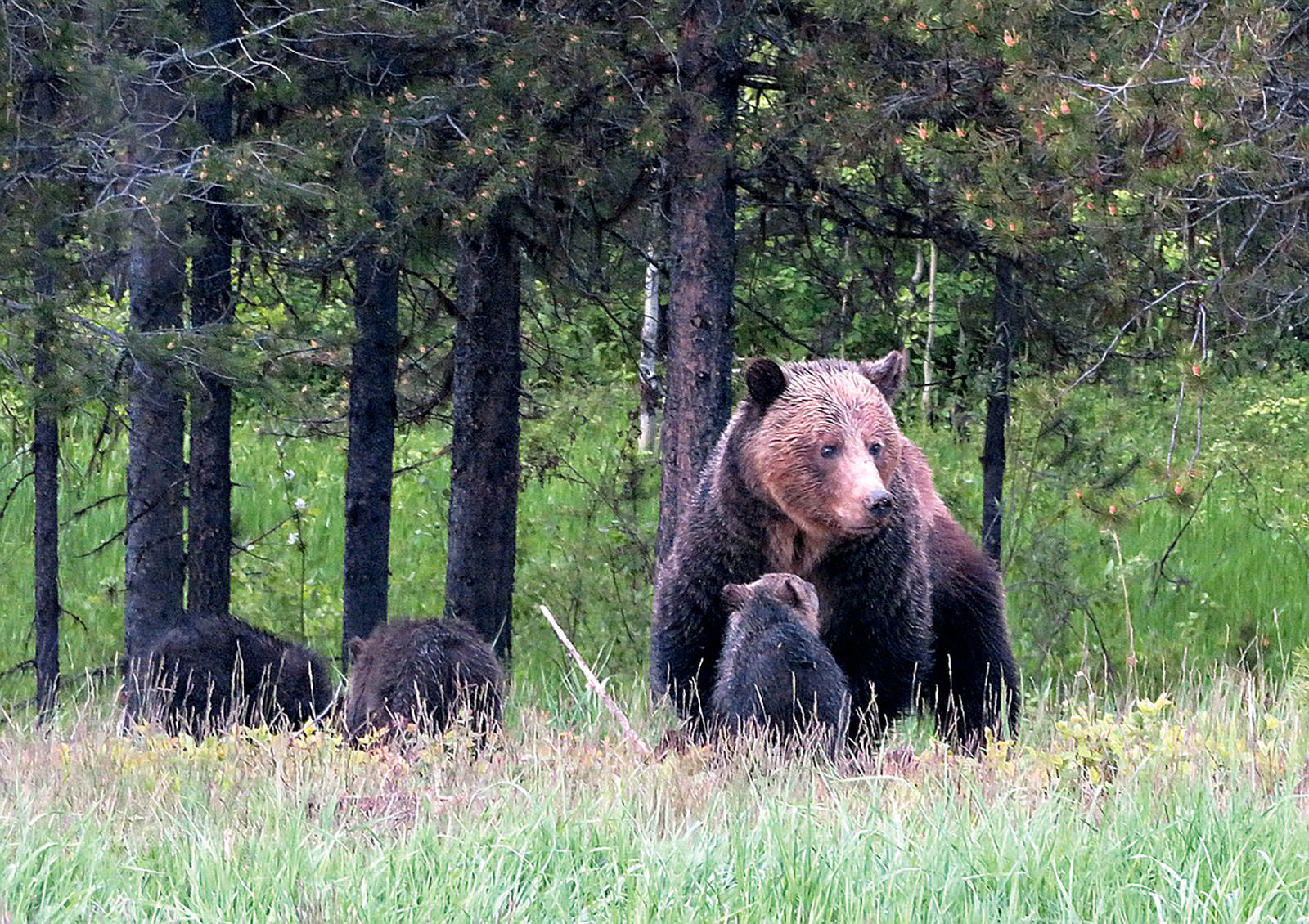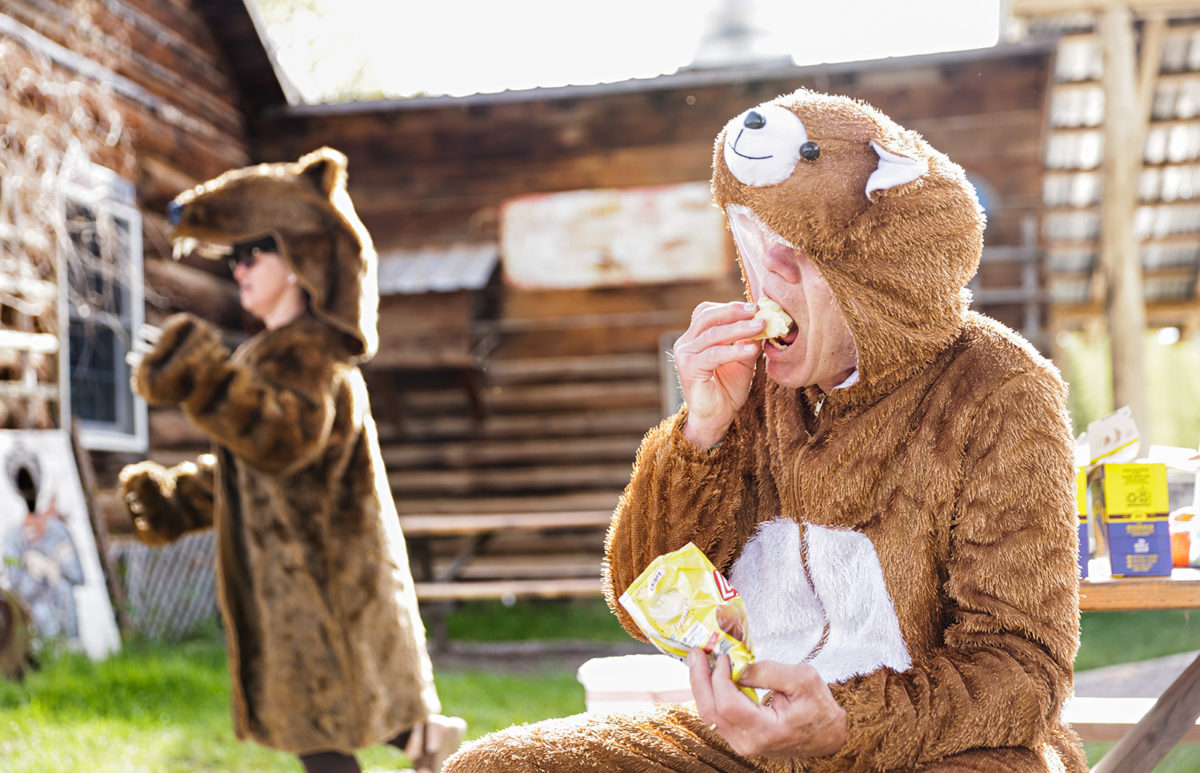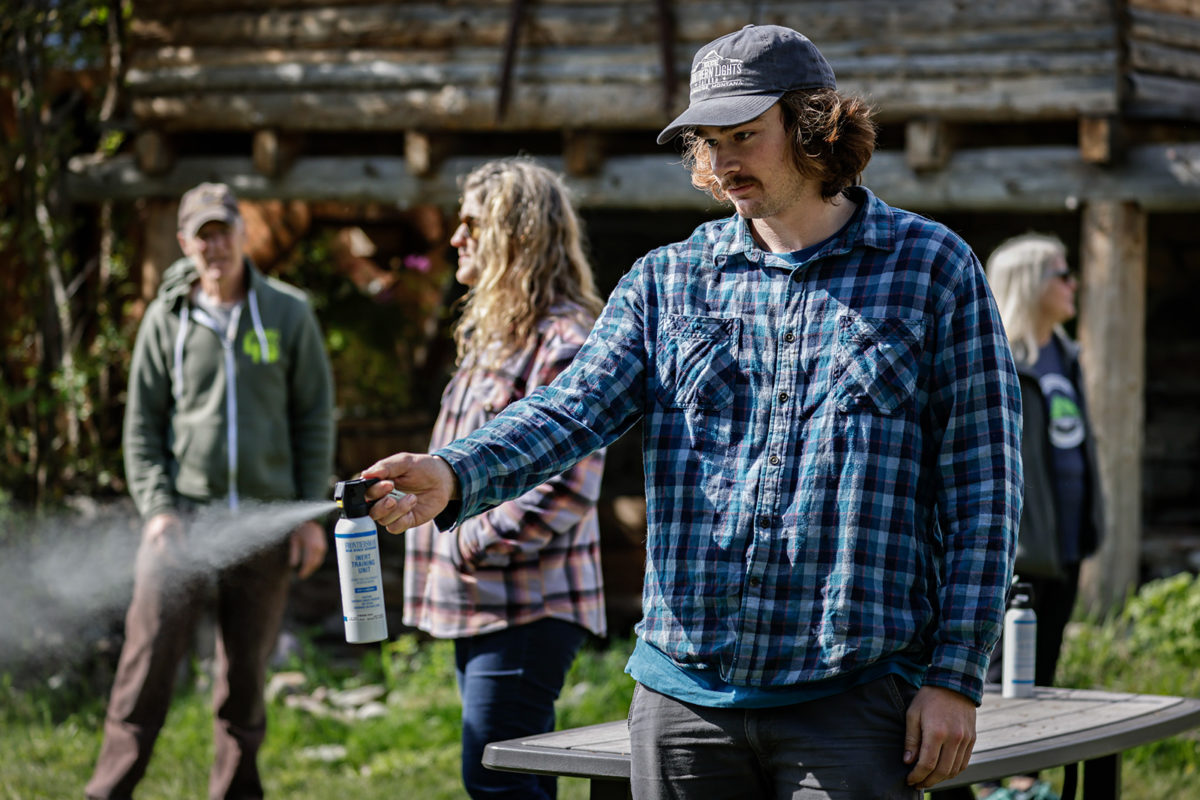
Smarter than the Average Bear
As the North Fork Flathead River Valley grapples with new residents and record visitation to Glacier National Park, incidents involving unsecured garbage and food-conditioned bears last year led to the management deaths of a beloved resident sow and her three cubs. This year, locals are ramping up outreach efforts to be a bear-smart community.
The sun was just peeking out from behind the Livingston Range last Thursday morning when Northwest Montana’s leading grizzly bear management specialist arrived at the site, but it was already too late. Beer and soda cans littered the patio outside the Northern Lights Saloon in Polebridge. Shredded candy bar wrappers and the salty contents of a Lay’s potato chip bag decorated the lawn. An upended trash bin and a flattened rucksack might have been confetti cannons broadcasting the refuse of the prior evening’s festivities.
It resembled a scene straight out of a bear-aware nightmare.
The two bruins were still gorging on garbage when Justine Vallieres parked her Montana Fish, Wildlife and Parks (FWP) pickup truck out front and marched toward them, carrying a six-pack of inert bear-spray canisters and smiling broadly.
“Well, you sure did make a mess, didn’t you?” she asked the bears before turning to face an audience of seasonal employees seated on nearby picnic tables — cooks and bakers, bartenders and dishwashers, many of them from out of state, all of them preparing to spend their summer on the doorstep of Glacier National Park, deep in the heart of grizzly country. The twentysomethings appeared both amused by the bears, who were actually human volunteers in bear costumes acting out a worst-case-scenario simulation, and alternately frightened as it occurred to them how easily such a scenario could unfold in real life.
Joining Vallieres for the presentation were Debo Powers and Suzanne Hildner of the newly minted Polebridge Bear Smart Program, an initiative that includes training sessions targeting seasonal workers at the bars, restaurants and bakeries serving the North Fork Flathead River Valley, which girds the park’s increasingly busy northwest entrance. Through a grant and private donations to the North Fork Preservation Association (NFPA), the group also furnishes residents and seasonal worker camps with animal-resistant trash containers through a loaner program, gives tutorials on how to safely use bear-deterrent pepper spray and is helping to organize the annual Polebridge Bear Fair on July 30 at Home Ranch Bottoms.
“Ultimately our goal is for you to learn to become allies to bears and, by learning the correct way to live in bear country, to become an ambassador for bears,” Powers explained. “Because all of the new people visiting the North Fork who don’t know anything about bears are going to be asking you 1,000 questions this summer and if you can provide them with good information, you can help avoid a situation like the one we had last summer.”

Despite the moments of comic relief provided by the snack-eating, soda-swigging bears, the reference to last summer’s events were a sobering reminder that living in grizzly country is no joke.
Situated on the doorstep of Glacier National Park, which merges with the Bob Marshall Wilderness to create the largest intact natural ecosystem in the Northern Rockies, the North Fork’s resident grizzly bear population has historically outnumbered its year-round residents. Still, the human interlopers who do call this wild chunk of country home have learned to coexist with their carnivorous neighbors, reaching an accord that just comes with the territory in bear country.
And yet in recent years, due in part to the increased visitation at Glacier National Park, whose western boundary is defined by the North Fork Flathead River, as well as the expansion of commercial services in and around the community of Polebridge — leading to the development of “work camps” to house a growing seasonal staff — human-wildlife conflicts have been on the rise.
Last summer, those conflicts led to the difficult management decision to kill four food-conditioned grizzlies in the North Fork, including Monica, a well-known resident sow, and her three yearling cubs, all of them female. The decision followed a spate of escalating incidents involving property destruction, including camp trailers and vehicles, resulting in significant food rewards for the bears.
“I have said it many times before,” Tim Manley, FWP’s longtime grizzly bear management specialist who retired last year, said at the time, “killing bears is the worst part of my job. We try to avoid having to do it but when bears become very food-conditioned and start causing property damage and breaking into vehicles, trailers and cabins, those bears are removed.”
For three decades, Manley worked to resolve conflicts between grizzly bears and people in Northwest Montana, in large part by forging relationships with landowners and shifting perceptions about how to coexist on a crowded landscape. Nowhere have those relationships been more enduring than up the North Fork, where Manley dedicated untold resources as the grizzly population recovered and its habitat range blossomed, coinciding with an influx of human inhabitants. In the wake of Manley’s retirement, North Fork residents breathed a sigh of relief when it was announced that Vallieres was stepping up to fill his position. As Manley’s longtime field companion and technician of four years, Vallieres learned from the best. She also learned the hard way that killing bears is part of the job, and that teaching humans how to avoid those consequences is among the most poignant measures for success.
“We have spent a lot of time in the North Fork talking to landowners and visitors about preventing conflicts,” she said, adding that, with the snowpack lingering later than usual this summer in the high country, “there are so many bears along the North Fork and down in the valleys right now.”
As if to underscore her point, Vallieres shared a recent incident involving a 22-year-old boar grizzly she had to kill in Polebridge after FWP received numerous reports of the bear frequenting homes up the North Fork, browsing on clovers and sweet grass in the yards of residents and refusing to leave. Having grown too comfortable in the presence of humans and with deteriorating teeth and health, Vallieres captured the bear on May 26 and said she couldn’t in good conscience release him.
“If he’d been a young bear in good health, I would have collared him and knocked him loose, but the way his teeth looked and given his advanced age there weren’t any other good options,” Vallieres told the audience. “Just as it was with Monica, it was a heartbreaking decision. Monica had a tear rolling down her eye when we put her down. Killing bears is absolutely the worst part of this job but initiatives like this do help prevent that outcome.”

Indeed, the death of Monica and her three cubs prompted community stakeholders up the North Fork to ramp up their outreach and education efforts to provide business owners, visitors and new residents with the tools and resources necessary to safely occupy bear country. The objective is to prevent the conditioning of wildlife to human food and waste, which is at the heart of the popular adage, “A Fed Bear is a Dead Bear.”
Monica, who was tagged with the official designation of Bear No. 418 after her first capture in 2004 at the site of a calf depredation on the east side, was relocated to the western edge of Glacier National Park. She remained there for the ensuing 17 years, spending a majority of her time in Glacier, while denning in Hay Creek and on Cyclone Peak above the North Fork.
“During those 17 years she was captured twice in culvert traps set for research,” Manley wrote in a report posted on the North Fork Preservation Association’s (NFPA) website. “She wore the radio collars for a few years before they dropped off. During those 17 years, we documented her having at least four litters. Two litters of two and two litters of three.”
While Monica often spent time near homes and was observed by residents, Manley explained, she did not cause conflicts “that we knew about” until the fall of 2018, when she and two of her three yearlings ripped into a yurt, damaged two vehicles, consumed unsecured garbage, and pushed on a trailer. Observers reported that the two yearlings were causing the conflicts, and Manley made the always-difficult decision to lethally remove them. Last year, Manley received several reports of Monica and her three cubs of the year in the Hay Creek area, but the sightings didn’t involve any documented conflicts.
“The spring and early summer of 2021 were pretty quiet except I did get a report of grizzly bears getting into a garage to get garbage above Polebridge,” according to Manley’s report. “In late August, that changed.”
The escalating behavior resulted in numerous reports of the bears knocking over barbecue grills, accessing bear-safe garbage containers with malfunctioning locks, breaking into a horse trailer used to store garbage, as well as a pickup topper, and attempting to break into a garage to access garbage. The incidents came to a head on Sept. 1, 2021, when Manley received a report that grizzly bears had broken into an unoccupied camp trailer on property near Home Ranch Bottoms, causing extensive damage and receiving a “big food reward.”
By Sept. 4, all four bears had been captured, with Manley administering lethal doses of euthanasia.
“When I heard about this, honestly I wept,” Richard Hildner, a North Fork resident and president of the North Fork Landowners Association (NFLA), said. “We were all just sick and saddened, and we are determined to step up as a bear safe community. It is incumbent on both the public and our local commercial entities to prevent bear habituation to human food and garbage.”
“The whole community grieved,” Powers said. “We were devastated.”

The owners of local businesses have been overwhelmingly supportive of the new initiatives, as have their new employees. Heather Matthews, owner of the Northern Lights Saloon that hosted the Polebridge Bear Smart Program’s most recent June 2 training initiative, said her workers were eager to learn more about how to safely live, work and play in bear country. Still, she conceded it’s easy to grow careless as the summer drags on, so she fines her employees if they don’t properly secure their trash or attractants.
“It’s so easy to get complacent and leave your empties out, but it’s also a really easy behavior to correct,” Matthews said. “I am trying to be a better leader, a better educator and just be better as a business. It’s unfortunate that what happened last year happened, but it brought the consequences of our behavior into clearer reality. I think it showed all of us that we could all be doing better.”
According to Vallieres, she’s been tracking a grizzly bear named Dani who’s been visiting all of Monica’s old haunts, and while Dani has yet to receive a food reward or cause any conflicts, Vallieres speculates that she’s Monica’s offspring. But just because she’s learned some bad habits doesn’t mean they have to be reinforced.
“We won’t know until later this year when we get the DNA results back, but I wouldn’t be surprised if she’s one of Monica’s,” Vallieres said. “That means the North Fork has the chance to do right by Monica. We have the opportunity to learn from Monica and get it right this year.”